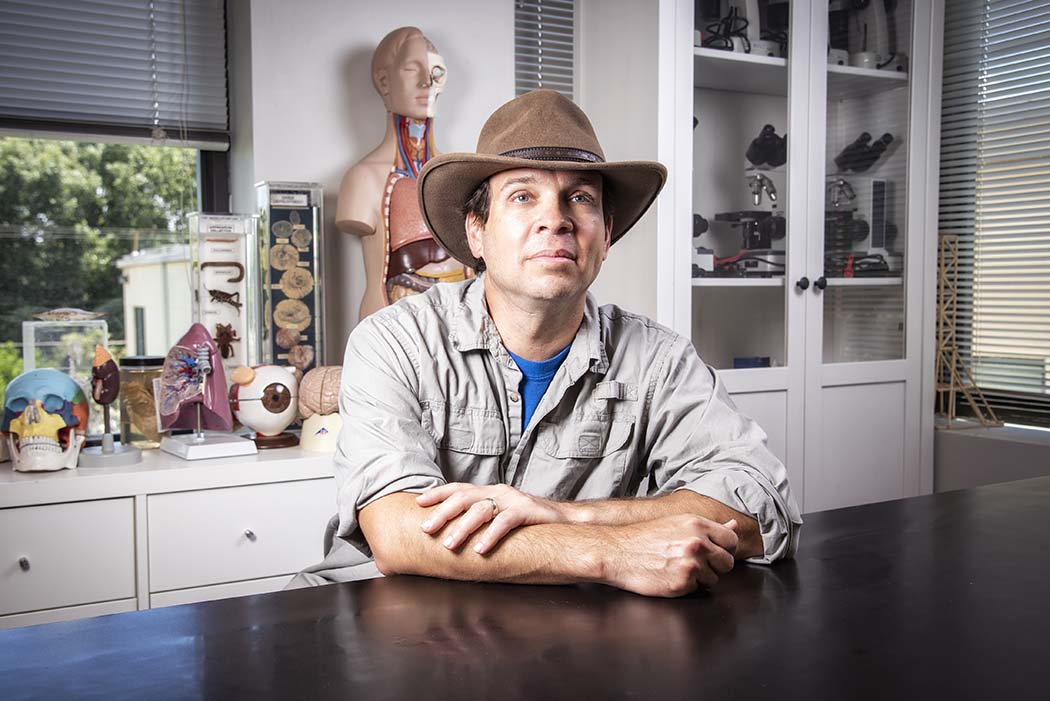
Photography by Danny Fulgencio
Jeremy Holman’s science classes are a favorite among morbidly curious students who love to see flesh pulled away from the human body until the bone is exposed and ready to cut.
Holman is just as excited to teach them about it.
Last year, the nine-year veteran at Lakehill Preparatory School had his jaw reconstructed after doctors found a cancerous tumor. When he returned to work, he came equipped with pictures, videos and models of his jaw. Students came with plenty of questions.
“Students ask, ‘Hey, Mr. Holman, I heard you can see the tendons in your leg. Can we see? I’m like, ‘Yeah, sure,’” he says.
Holman never forces students to look at images that could be considered graphic. But even those without iron stomachs are curious about the pain or his new diet — only soft foods like yogurt and eggs.
“From the first diagnosis, I wanted the kids to know about it,” Holman says. “It’s educational, but it’s also empowering to not be fearful of medicine or health problems or surgery.”
In January 2019, Holman’s dentist found what he thought was a tooth infection and recommended a root canal. But Holman had just had surgery and put it off. Over the next six months, a bulge the size of a golf ball gradually emerged above his lip, causing his face to swell. It wasn’t until he had his picture taken while renewing his driver’s license that he noticed the protrusion.
“I was looking at the picture and was like, ‘Why are these always so awful?’” Holman says. “I was looking in the mirror later that day and was like, ‘Wait a minute. That’s my face.’”
He went back to the dentist, who referred him to an endodontist. The endodontist said it was a cyst, and a surgeon needed to operate. The surgeon then said it was a tumor, but it was probably benign. When the test came back, the tumor was malignant.
“The story kept getting worse and worse,” Holman says.
During a two-month medical leave, Holman had surgery to remove the tumor and most of his upper jaw. Surgeons replaced the missing bone with his fibula, a non-weight-bearing bone in the leg, and installed temporary dental implants. The process usually takes three surgeries, but Holman completed it in one day over 13 hours.
The Lakehill community rallied around the science teacher. A former student started a GoFundMe that raised more than $35,000 to cover nearly all the family’s out-of-pocket expenses.
“You teach because of the relationships,” Holman says. “Sometimes you wonder if what you’re doing matters. When people reacted the way they did, it wasn’t just the students in my classes. It was students I didn’t even teach. It was overwhelming to think about. Not just the money, but the love.”

Holman returned to Lakehill in January. Less than three months later, the coronavirus hit. Holman was well equipped for the shutdown in terms of curriculum, but he was not as prepared for the emotional impact.
“I have missed so much time with these students because of my cancer, and the prospect of missing another month or more is just really sad,” Holman wrote in a March email. “There are going to be two big holes that just can’t be filled. As I will tell the students though, all we can do is get up every day and start doing the next right thing.”
And that’s what they did.
Holman created videos to accompany PowerPoint presentations that he uploaded to Google Classroom. For his anatomy and physiology class, he led virtual labs on the kidneys and digestive system. For biology, he found a free video series on the diversity of animals. Students showed mastery of the material through daily digital quizzes. Keeping students motivated after the first two weeks of online learning was a challenge. Zoom classes are better than nothing, Holman says, but the online platform fails to foster class discussion and makes it difficult for students to focus. For the remainder of the semester, students worked on projects about infectious diseases or the biology found at national parks.
When classes resume at Lakehill on Aug. 24, the first two weeks will be online, with in-person learning scheduled to start Sept. 8. Students will be required to wear a face covering, and plexiglass dividers will be installed between seats at lab tables. Classes will finish early so instructors can disinfect the rooms before the next group arrives.
“I’m excited to go back,” Holman says. “Our school and our community seem like they’ve taken this very seriously. We have plenty of safeguards in place, and I think we’re going to be OK.”
The curriculum for all Holman’s classes includes a well-timed unit on infectious diseases. Not only will Holman examine COVID-19 and the new ways researchers are rapidly creating a vaccine, but he’ll also teach students about the scientific process.
“People are aggressive against science right now,” Holman says. “We come out with information and then have to go back on some of it. We’re used to seeing settled science, but we’re seeing it live now, and this is the way it works.”
Other changes include deferring lab- intensive curriculum to the second semester, when coronavirus cases may have decreased or a vaccine is available.
“I want to share my passion for biology, but I also talk to students about dealing with challenges in life,” he says. “I get to help create leaders who will make positive change. It’s more than just science.”




